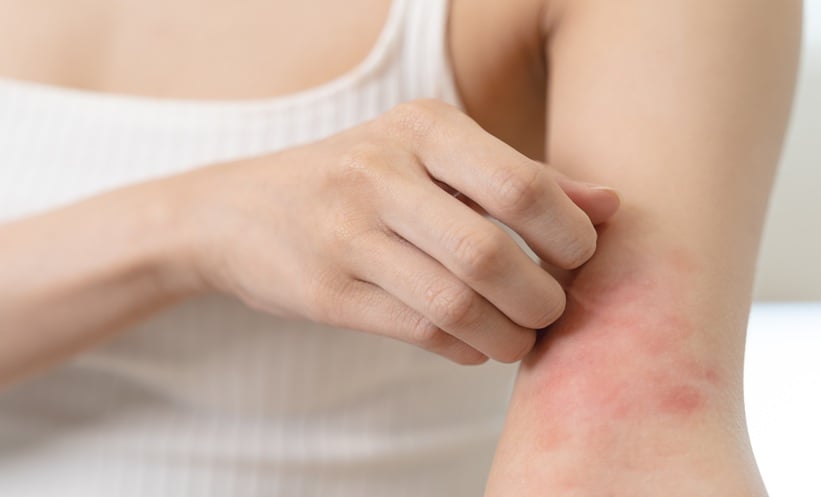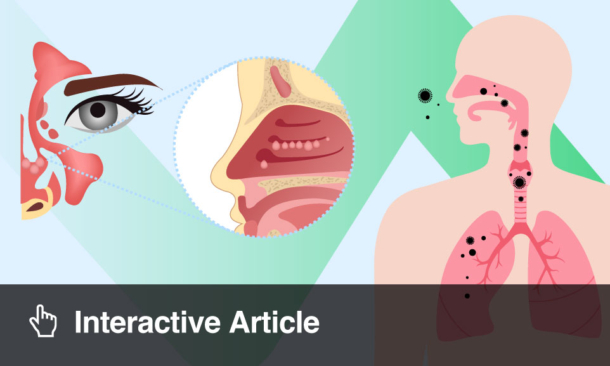Authors: Kathryn Smiley,1,2 Lauren Galli,1,2 *Bob Geng1-3
1. Allergy & Asthma Medical Group and Research Center, San Diego, California, USA
2. Rady Children’s Hospital, San Diego, California, USA
3. University of California, San Diego, California, USA
*Correspondence to [email protected]
Disclosure: Smiley has been a consultant for Novartis outside of the submitted work. Geng has received speaker/consultancy fees and/or research support from Sanofi, Regeneron, Genentech, Novartis, Jasper, and Incyte outside of the submitted work. Galli has declared no conflicts of interest.
Acknowledgements: Medical writing assistance was provided by Katie Wright, EMJ, London, UK.
Keywords: Angioedema, autoimmune, burden, chronic spontaneous urticaria (CSU), mast cells, pathophysiology.
Citation: EMJ Allergy Immunol. 2025;10[1]:24-27. https://doi.org/10.33590/emjallergyimmunol/XBEL1976
![]()
BURDEN ON QUALITY OF LIFE
A persistent and often debilitating condition, affecting up to 1% of the population at any given time, CSU is characterised by spontaneous wheals, intense pruritus, and angioedema (present in approximately 40% of patients), imposing a significant burden. Among these symptoms, pruritus is widely considered the most distressing, often compelling patients to seek urgent relief.1
The unpredictable nature of CSU takes a substantial toll on patients’ QoL. Flares can occur without warning, disrupting sleep and day-to-day activities. Psychologically, the disease is linked to heightened rates of anxiety and depression, with patients often feeling isolated and helpless in managing their symptoms. Beyond the physical and emotional strain, CSU carries a notable economic burden, leading to increased healthcare utilisation, absenteeism from work or school, and lost productivity.2 The cumulative effect of these burdens drives the pressing need for more effective and durable treatments.
PATHOPHYSIOLOGY OF CHRONIC SPONTANEOUS URTICARIA
At the heart of CSU pathogenesis lies the mast cell, a key effector of allergic and inflammatory responses. Mast cells interact with a host of other immune cells, including basophils and T cells, to drive the clinical manifestations of CSU. Upon activation, mast cells release histamine and other inflammatory mediators that cause the hallmark wheals and angioedema.
Two main autoimmune mechanisms are proposed in CSU: Type I autoimmune CSU involves auto-IgE antibodies that bind to allergens or self-antigens, while Type IIb involves IgG autoantibodies that target Fc epsilon receptor I (FcεRI) or IgE directly.3 Despite these two distinct descriptions, many patients show overlapping features of both types, complicating diagnosis and treatment.
The survival and activation of mast cells is critically dependent on stem cell factor (SCF) and its receptor, cKIT. Disruption of this axis, especially in skin-resident mast cells, has emerged as a promising therapeutic strategy in CSU.
CURRENT TREATMENT LANDSCAPE AND GOALS
The primary goal in treating CSU is to achieve complete symptom control, defined as an Urticaria Activity Score over 7 days (UAS7) of 0, which reflects the resolution of hives, itch, and angioedema. Reaching this target not only alleviates physical symptoms, but also has the potential to significantly improve mental health and QoL.
The current treatment algorithm begins with second-generation H1-antihistamines. If symptoms persist, guidelines recommend increasing the dose up to fourfold. For those who remain symptomatic, the next step is typically omalizumab, an anti-IgE biologic. In refractory cases, cyclosporin, an immunosuppressant, is considered, though it comes with notable side effects. Despite this structured approach, many patients fail to achieve full control, highlighting the need for newer, more targeted therapies.
CURRENT AND EMERGING TREATMENT OPTIONS
Omalizumab
Omalizumab, a monoclonal antibody that neutralises free IgE, has transformed CSU management, demonstrating efficacy, particularly in patients who are unresponsive to high-dose antihistamines. In Phase III trials (ASTERIA I and II),2 36–40% of patients achieved UAS7=0 with a 300 mg dose every 4 weeks. Omalizumab acts quickly, with many patients experiencing relief within the first few weeks. Importantly, it is well tolerated, is suitable for use during pregnancy, and carries a low risk of anaphylaxis. Omalizumab was approved in 2014 by the FDA and EMA for the treatment of CSU in patients ≥12 years of age who remain symptomatic despite treatment with H1 antihistamines.
Dupilumab
Dupilumab, another monoclonal antibody, targets IL-4 and IL-13 pathways, disrupting key drivers of Type 2 inflammation. In the LIBERTY-CSU Study A and Study C, also referred to as the CUPID-A and CUPID-C trials, dupilumab achieved UAS7=0 in about 30% of patients by Week 24.3 However, it missed its primary endpoint in the CUPID-B trial, likely due to patient selection (many were not omalizumab-naïve).4 Despite this, dupilumab is well-tolerated and remains a promising option, especially for those with comorbid atopic diseases.3 Dupilumab was recently approved by the FDA in April 2025 for treatment of CSU in patients ≥12 years who remain symptomatic despite antihistamine treatment, and is currently under review with the EMA.
Barzolvolimab
Barzolvolimab introduces a novel approach by targeting the cKIT receptor with a selective covalent monoclonal antibody. This disrupts SCF binding and starves mast cells, leading to their depletion via apoptosis, particularly in the skin. In Phase II trials, barzolvolimab demonstrated high rates of UAS7=0 at both 150 mg and 300 mg doses.6 Remarkably, symptoms remained low for months after the last dose, suggesting a disease-modifying effect, though more research is needed to investigate long-term off-therapy data.7 The safety profile is generally predictable and mild, with side effects such as hair colour changes, neutropenia, and hypopigmentation, all consistent with the drug’s on-target mechanism.8
Briquilimab
Briquilimab is a monoclonal antibody that targets cKIT, offering a similar mechanism to barzolvolimab, but with distinct pharmacological properties. In the BEACON Phase Ib/IIa study,9 early data showed rapid, dose-dependent UAS7 reductions: a single 240 mg dose led to a mean UAS7 decrease of –26.6 at 8 weeks, with 100% of patients (3/3) in that cohort achieving UAS7=0 and maintaining complete responses up to Week 8. Sustained tryptase suppression below quantifiable levels was also documented. Data from the SPOTLIGHT Phase Ib/IIa trial10 in chronic inducible urticaria showed that in the 180 mg cohort (n=12), 100% achieved a clinical response, and 92% (11/12) reached complete response by Week 8. Moreover, by Week 2, 66% had already responded, and 58% maintained this response at Week 8. Side effects reported to date have included mild-to-moderate events, such as transient neutropenia and skin pigmentation changes, consistent with its on-target effects. Briquilimab is currently undergoing Phase II evaluation in patients with CSU who remain symptomatic despite antihistamines, and may represent another disease-modifying option in the evolving treatment landscape.
Remibrutinib
Remibrutinib, an oral, covalent Bruton’s tyrosine kinase (BTK) inhibitor, offers yet another innovative mechanism. By inhibiting BTK, it blocks downstream signalling that leads to mast cell degranulation, and may also modulate autoimmune processes. In the REMIX-1 and REMIX-2 Phase III trials, remibrutinib showed a rapid onset of action (within 1–2 weeks) and durable efficacy.11 More than 50% of patients achieved UAS7=0 by Week 52 in Phase IIb studies, and about one-third reached complete control at Week 12 in Phase III. It is well tolerated, with most adverse events being mild to moderate.11 Petechiae were noted in 3.8% of patients versus 0.3% on placebo, but did not raise broader safety concerns.11
CHALLENGES AND FUTURE DIRECTIONS
Despite advances, many patients remain inadequately controlled. Studies estimate that up to 76% of adults continue to experience symptoms,12 with approximately 60% being refractory to antihistamines and 27–30% showing no meaningful response to omalizumab.13 This persistent unmet need highlights the urgency for better therapies.
Moving forward, treatment goals are shifting from merely reducing symptoms to achieving complete disease control. As the therapeutic pipeline expands, especially with agents such as barzolvolimab, briquilimab, and remibrutinib, there is renewed hope for patients who previously had few options. Precision medicine, which involves tailoring treatments to specific disease mechanisms, such as autoimmune markers or mast cell profiles, may soon redefine how CSU is managed.





